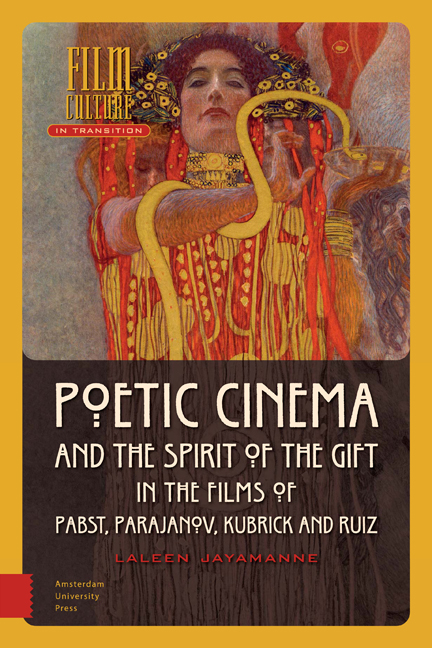Book contents
- Frontmatter
- Dedication
- Contents
- Foreword: In Memory of Thomas Elsaesser
- Introduction: Spirit of the Gift: Cinematic Reciprocity
- 1 A Gift Economy: G. W. Pabst’s Pandora’s Box (1929)
- 2 Fabric of Thought: Sergei Parajanov
- 3 Nicole Kidman in Blue Light: Stanley Kubrick’s Eyes Wide Shut (1999)
- 4 Ornamentation and Pathology: Raúl Ruiz’s Klimt (2006)
- Afterword: Poetics of Film Pedagogy
- Bibliography
- Filmography
- About the Author
- Index
3 - Nicole Kidman in Blue Light: Stanley Kubrick’s Eyes Wide Shut (1999)
Published online by Cambridge University Press: 13 April 2021
- Frontmatter
- Dedication
- Contents
- Foreword: In Memory of Thomas Elsaesser
- Introduction: Spirit of the Gift: Cinematic Reciprocity
- 1 A Gift Economy: G. W. Pabst’s Pandora’s Box (1929)
- 2 Fabric of Thought: Sergei Parajanov
- 3 Nicole Kidman in Blue Light: Stanley Kubrick’s Eyes Wide Shut (1999)
- 4 Ornamentation and Pathology: Raúl Ruiz’s Klimt (2006)
- Afterword: Poetics of Film Pedagogy
- Bibliography
- Filmography
- About the Author
- Index
Summary
Abstract
The strange, inexplicable movement of light and colour of the image is examined in relationship to Nicole Kidman's unique form of acting in this film. Kidman acts in slow motion. The dynamism of colour and Kidman's slowed-down speech acts are explored to show how, together, they transform the relationship between the heterosexual married fictional couple Alice and Bill, played by the real-life couple Kidman and Cruise. Kubrick taps into and draws out Kidman's metamorphic powers as an actor. The industrial, technical, and aesthetic context is Kubrick's experiments with light and colour on celluloid, at the moment of its obsolescence.
Keywords: Stanley Kubrick, Nicole Kidman, Acting in slow motion, Celluloid cinema, Light and colour
Not too long ago, a fragment of dialogue spoken by Nicole Kidman in Eyes Wide Shut appeared in a rather unlikely place: Frank Ocean's song Love Crimes (2015). We hear it just under his vocals. The dialogue is taken from the scene in which Kidman's Alice Harford picks an argument with her husband Dr Bill Harford, played by Tom Cruise. They are arguing about a ‘love crime’ that has not actually been committed, but simply imagined. The then real-life husband and wife couple ‘play-act’ as a married couple in Stanley Kubrick's final film, Eyes Wide Shut (1999). By doubling the real couple and a fictional married couple, Kubrick makes his images simulacral. We cannot truly distinguish between the real and the fictional couple. They seem to bleed into each other. They have entered an economy of simulation where the distinction between the original and the copy becomes blurred, undecidable. We find ourselves in an inflationary realm of images from which there appears to be no exit.
When the much-anticipated film, set in contemporary New York (though based on Arthur Schnitzler's Dream Novella, set in Vienna in the early twentieth century), was released soon after Kubrick's death, its public and critical reception was less than favourable. Some of the criticism was very harsh and Kidman's performance was especially targeted. That a piece of contemporary popular music should quote Eyes Wide Shut in 2015 interested me at the time and I want now to reconsider the acting in the film, as well as Kubrick's innovation in film lighting and colour and their interrelationships, on the threshold of the obsolescence of celluloid as light sensitive medium.
- Type
- Chapter
- Information
- Poetic Cinema and the Spirit of the Gift in the Films of Pabst, Parajanov, Kubrick and Ruiz , pp. 111 - 126Publisher: Amsterdam University PressPrint publication year: 2021



